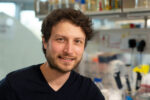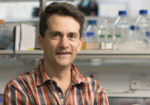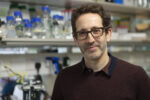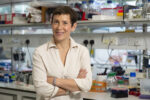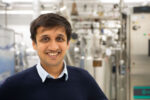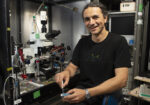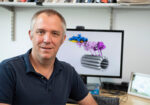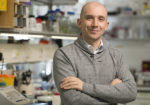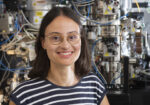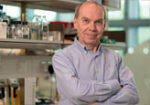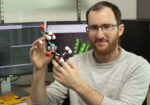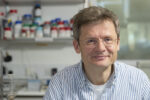A-to-G
Matteo Allegretti
LMB Division - Structural Studies
The macromolecular basis of nuclear shape and remodelling
The cell is the simplest living metabolic entity. Organelles are cellular compartments specialized in a certain function. The nucleus is the essential cell compartment containing the genetic information. Our research aims to understand the molecular basis of how the nucleus is remodelled in shape during differentiation processes or due to environmental cues. More…
Radu Aricescu
LMB Division - Neurobiology
The structural biology of neuronal connectivity
Neuronal circuits are the biological substrates for all aspects of brain function such as learning, memory, thought, speech or consciousness. The synapses, connecting points between neurons, are continuously remodelled in response to novel experiences and hold the key to understanding how these circuits work. More…
Diana Arseni
LMB Division - Neurobiology
Lysosomal TMEM106B in brain ageing and disease
We investigate lysosomal dysfunction in brain health, ageing and disease by focusing on transmembrane protein 106B (TMEM106B), a lysosomal protein. Genetic and clinical studies have implicated lysosomal dysfunction as a key contributor to ageing and neurodegeneration. More…
David Barford
LMB Division - Structural Studies
Mechanism and regulation of chromosome segregation in mitosis
The anaphase-promoting complex (APC/C) is a large multi-subunit complex (~1.2 MDa) that functions to regulate cell cycle transitions, specifically the metaphase to anaphase transition in mitosis (when duplicated sister chromatid pairs are separated), the exit from mitosis and maintenance of G1. More…
Buzz Baum
LMB Division - Cell Biology
The generation and evolution of biological form: from archaea to eukaryotes
My lab is interested in the generation of biological form or “morphogenesis”. While we have long studied morphogenesis in the context of developing tissues, our main focus has always been on events at the cellular scale. More…
Anne Bertolotti
LMB Division - Neurobiology
Understanding and manipulating cellular resilience in health and disease
Deposition of proteins of aberrant conformation is the hallmark of several neurodegenerative diseases such as Alzheimer’s disease, Parkinson’s disease, Huntington’s disease, amyotrophic lateral sclerosis and prion disorders. Cells have elaborate quality control mechanisms to protect them from the deleterious effect of misfolded proteins. More…
Tanmay Bharat
LMB Division - Structural Studies
Role of Surface Molecules in Microbial Multicellularity
Our laboratory uses electron tomography, combined with several structural and cell biology techniques, to study cell surfaces of prokaryotes at the atomic level. More…
Simon Bullock
LMB Division - Cell Biology
Molecular cell biology of cytoskeletal transport
Molecular motors have critical roles in trafficking of organelles and macromolecules within the cytoplasm, and aberrant motor function has been implicated in diseases such as neurodegeneration. More…
Albert Cardona
LMB Division - Neurobiology
Experimental and comparative connectomics
The brain works as an integrated whole. Animals interact with the world by combining inputs from their senses of vision, hearing, smell, taste, touch and multiple others, with memories of past experiences, to then select a single, appropriate motor response that we observe as behavior. More…
Andrew Carter
LMB Division - Structural Studies
The structure and mechanism of dyneins
The contents of eukaryotic cells are organised and moved around by motor proteins running along the tracks that make up the cytoskeleton (microtubules and actin filaments). The largest and most complicated of these is the microtubule motor cytoplasmic dynein. More…
Jason Chin
LMB Division - Protein and Nucleic Acid Chemistry
Systematic genetic code reprogramming / Centre for Chemical and Synthetic Biology
Biomolecules and their dynamic assemblies, in collaboration with the energy provided by NTP hydrolysis, perform a spectacular range of mechanical and chemical manipulations on nanometre scale objects in the cell; molecular motors perform mechanical work, while enzymes rearrange atoms in ways, and at rates that synthetic chemists have difficulty emulating. More…
Emmanuel Derivery
LMB Division - Cell Biology
Molecular basis of cell polarisation and asymmetry
Our goal is to establish the molecular mechanisms that generate cytoskeletal asymmetries during asymmetric cell division and to determine how, in turn, these cytoskeletal asymmetries generate polarized trafficking/signaling during development. More…
Juliette Fedry
LMB Division - Cell Biology
Cellular proteostasis networks in physiology and diseases
Cellular proteostasis networks in physiology and diseases More…
Michel Goedert
LMB Division - Neurobiology
Molecular mechanisms of neurodegeneration
Alzheimer’s disease and Parkinson’s disease are characterized by the presence of abnormal filamentous assemblies within some nerve cells. Similar assemblies are found in several related disorders. The events leading to filament formation or the mere presence of filaments are believed to produce nerve cell degeneration. More…
Joe Greener
LMB Division - Structural Studies
Improving force fields for biomolecular simulation
Molecular dynamics has shown success in obtaining biological insights by providing mechanistic interpretations of experimental data. However, the force fields used to describe how the atoms interact are biased towards keeping folded proteins folded and fail when applied to disordered proteins or protein aggregation. More…
Ingo Greger
LMB Division - Neurobiology
AMPA receptor biogenesis, structure and function
Information transfer in the nervous system occurs at synapses where presynaptic signals are interpreted by postsynaptic receptors. We study this process with a focus on AMPA-type glutamate receptors, at various levels of complexity. More…
